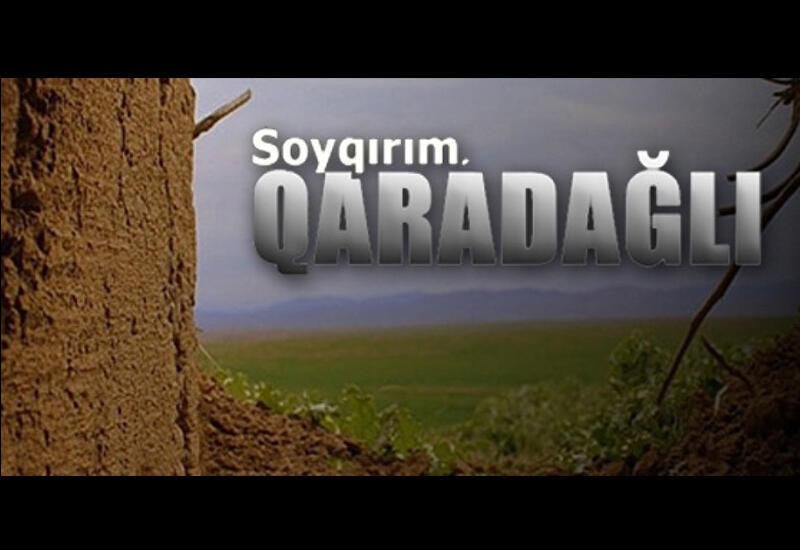Azerbaijan marks 30th anniversary of Garadaghli massacre

By Vugar Khalilov
Azerbaijan marks the 30th anniversary of the Garadaghli massacre committed by Armenian terrorists against the Azerbaijanis in 1992.
For four years, the Garadaghli village of Khojavand region fought valiantly against Armenian aggressors. On February 17, 1992, the village was occupied and burned, and the massacre was committed against the civilian population.
The massacre and torture of villagers here 30 years ago were continuations of Armenian nationalists' policy of ethnic cleansing and genocide against Azerbaijanis for nearly 200 years, as a result of their hatred for Azerbaijanis.
Garadaghli village is located 13 kilometers west of Khojavand region's center, on the side of the Khojavand-Khankandi highway, in the foothills. The tragic days of Garadaghli village in Khojavand region began in 1988 when Armenian separatists revolted in Nagorno-Karabakh.
The villagers fought for every inch and every stone of their childhood home, and dozens of them were killed in unequal battles with the Armenians.
Armenian armed formations launched an attack on the village of Garadaghli in Khojavand region beginning in early February 1992. It was a large village with over 800 houses. Back in 1991, the village was surrounded by Armenians, and the residents' power and roads were cut off. Armenians did everything they could to get Azerbaijanis out of their homeland.
Initially, women and children could be evacuated, but helicopters stopped flying in February 1992, and people were cut off from the rest of the world. Without any outside assistance, the Garadaghli people defended themselves valiantly until the cartridges ran out. For five days, 104 villagers and 14 soldiers resisted attacks by heavily armed gangs. Men defended the village, while women brought supplies and cared for the injured. But the forces were not equal, and the village fell on February 17.
Some 43 families lost their fathers and husbands, leaving 146 children orphaned. Some 200 houses were demolished. Approximately 800 villagers were internally displaced. In total, 91 people were killed in the village, accounting for one out of every ten residents. If the Azerbaijani units had not distracted the enemy with an attack on Khojavand, there could have been far more casualties.
The majority of the inhabitants of the besieged village were able to flee as a result of this attack. However, the Garadaghli defenders, mostly young people, refused to surrender the village without a fight and continued to resist.
The courage of the people of Garadaghli infuriated the Armenians, and a brutal massacre was perpetrated on the captured defenders of the village. 118 villagers were taken hostage, 33 people were shot on the spot. The prisoners were subjected to inhuman torture. 68 people died in captivity, 50 were rescued with great difficulty from the enemy. However, 18 of them subsequently died, unable to survive the consequences of the physical and moral suffering.
Armed Armenian gangs led by Monte Melkonyan committed the genocide in Garadaghli, which was planned in Syria and Lebanon by Arabo and Aramo terrorist units. As the investigation showed, military personnel from the infamous 366th regiment also participated in the occupation and subsequent massacre. According to the testimonies of those who took part in the defense of Garadaghli, the invaders included a large number of mercenaries.
Under extremely difficult circumstances, the Garadaghli people defended the village against the enemy. While the Armenians were arming and acquiring armored vehicles, the Azerbaijanis of Karabakh were disarmed on orders from Moscow.
As a result, the Azerbaijanis were confronted with a large, merciless, and heavily armed enemy. There was no assistance from Baku, so people formed self-defence detachments in villages, using their own money to buy hunting rifles in a roundabout way. From the start of the conflict until the capture of Garadaghli, the Garadaghli people were constantly forced to repel armed attacks by Armenian gangs. Garadaghli and Khojaly were on the strategically important roads of Khojavand-Khankandi and Khankendi-Askaran-Agdam, and the Armenians worked tirelessly to remove these impediments and advance the front line. In total, the siege of Garadaghli lasted four months...
What happened in Garadaghli was more than just a tragedy. It's also a story of bravery, of the heroic resistance of the village's civilians to the Armenian gangs, mercenaries, and army backing them. They died defending their homes and land, setting a good example for many others.
---
Follow us on Twitter @AzerNewsAz
Here we are to serve you with news right now. It does not cost much, but worth your attention.
Choose to support open, independent, quality journalism and subscribe on a monthly basis.
By subscribing to our online newspaper, you can have full digital access to all news, analysis, and much more.
You can also follow AzerNEWS on Twitter @AzerNewsAz or Facebook @AzerNewsNewspaper
Thank you!
